Microchip dsPIC33FJ12MC202马达控制开发方案
 146
146
 拍明
拍明
原标题:Microchip dsPIC33FJ12MC202马达控制开发方案
microchip 公司的dsPIC33FJ12MC201/202是高性能的16位数字信号控制器(DSC),包括有广泛的DSP功能和高性能的16位微控制器(MCU)架构.而dsPICDEM™ MCHV开发系统使用户能快速评估和开发采用dsPIC数字信号控制器(DSC)的各种马达应用,可以控制无刷直流(BLDC)马达,永磁同步马达(PMSM)和传感器或无传感器的AC感应马达(ACIM).本文介绍了dsPIC33FJ12MC201/202主要特性,方框图以及dsPICDEM™ MCHV开发系统方框图,主要特性和dsPICDEM™ MCHV开发系统包括PFC级与功率模块级的电路图.
The Microchip dsPICDEM™ MCHV Development System is intended to aid the user in the rapid evaluation and development of a wide variety of motor control applications using a dsPIC® Digital Signal Controller (DSC). This development system is targeted to control Brushless DC (BLDC) motors, Permanent Magnet Synchronous Motors(PMSM), and AC Induction Motors (ACIM) in sensor or sensorless operation.
dsPIC33FJ12MC201/202 : High-Performance, 16-bit Digital Signal Controllers The dsPIC33F devices contain extensive Digital Signal Processor (DSP) functionality with a high-performance, 16-bit microcontroller (MCU) architecture.
dsPIC33FJ12MC202主要特性:
Operating Range:
• Up to 40 MIPS operation (at 3.0-3.6V):
- Industrial temperature range (-40℃ to +85℃)
- Extended temperature range (-40℃ to +125℃)
High-Performance DSC CPU:
• Modified Harvard architecture
• C compiler optimized instruction set
• 16-bit-wide data path
• 24-bit-wide instructions
• Linear program memory addressing up to 4M instruction words
• Linear data memory addressing up to 64 Kbytes
• 83 base instructions: mostly one word/one cycle
• Two 40-bit accumulators with rounding and saturation options
• Flexible and powerful addressing modes:
- Indirect
- Modulo
- Bit-Reversed
• Software stack
• 16 x 16 fractional/integer multiply operations
• 32/16 and 16/16 divide operations
• Single-cycle multiply and accumulate:
- Accumulator write back for DSP operations
- Dual data fetch
• Up to ±16-bit shifts for up to 40-bit data
Timers/Capture/Compare/PWM:
• Timer/Counters, up to three 16-bit timers
- Can pair up to make one 32-bit timer
- One timer runs as Real-Time Clock with external 32.768 kHz oscillator
- Programmable prescaler
• Input Capture (up to four channels):
- Capture on up, down, or both edges
- 16-bit capture input functions
- 4-deep FIFO on each capture
• Output Compare (up to two channels):
- Single or Dual 16-bit Compare mode
- 16-bit Glitchless PWM mode
Interrupt Controller:
• 5-cycle latency
• Up to 26 available interrupt sources
• Up to three external interrupts
• Seven programmable priority levels
• Four processor exceptions
Digital I/O:
• Peripheral pin Select functionality
• Up to 21 programmable digital I/O pins
• Wake-up/Interrupt-on-Change for up to 21 pins
• Output pins can drive from 3.0V to 3.6V
• Up to 5V output with open drain configuration
• All digital input pins are 5V tolerant
• 4 mA sink on all I/O pins
On-Chip Flash and SRAM:
• Flash program memory (12 Kbytes)
• Data SRAM (1024 bytes)
• Boot and General Security for program Flash
System Management:
• Flexible clock options:
- External, crystal, resonator, internal RC
- Fully integrated Phase-Locked Loop (PLL)
- Extremely low-jitter PLL
• Power-up Timer
• Oscillator Start-up Timer/Stabilizer
• Watchdog Timer with its own RC oscillator
• Fail-Safe Clock Monitor
• Reset by multiple sources
Power Management:
• On-chip 2.5V voltage regulator
• Switch between clock sources in real time
• Idle, Sleep, and Doze modes with fast wake-up
Motor Control Peripherals:
• 6-channel 16-bit Motor Control PWM:
- Three duty cycle generators
- Independent or Complementary mode
- Programmable dead time and output polarity
- Edge-aligned or center-aligned
- Manual output override control
- One Fault input
- Trigger for ADC conversions
- PWM frequency for 16-bit resolution (@ 40 MIPS) = 1220 Hz for Edge-Aligned mode, 610 Hz for Center-Aligned mode
- PWM frequency for 11-bit resolution (@ 40 MIPS) = 39.1 kHz for Edge-Aligned mode, 19.55 kHz for Center-Aligned mode
• 2-channel 16-bit Motor Control PWM:
- One duty cycle generator
- Independent or Complementary mode
- Programmable dead time and output polarity
- Edge-aligned or center-aligned
- Manual output override control
- One Fault input
- Trigger for ADC conversions
- PWM frequency for 16-bit resolution (@ 40 MIPS) = 1220 Hz for Edge-Aligned mode, 610 Hz for Center-Aligned mode
- PWM frequency for 11-bit resolution (@ 40 MIPS) = 39.1 kHz for Edge-Aligned mode, 19.55 kHz for Center-Aligned mode
• Quadrature Encoder Interface module:
- Phase A, Phase B, and index pulse input
- 16-bit up/down position counter
- Count direction status
- Position Measurement (x2 and x4) mode
- Programmable digital noise filters on inputs
- Alternate 16-bit Timer/Counter mode
- Interrupt on position counter rollover/underflow
Analog-to-Digital Converters (ADCs):
• 10-bit, 1.1 Msps or 12-bit, 500 Ksps conversion:
- Two and four simultaneous samples (10-bit ADC)
- Up to six input channels with auto-scanning
- Conversion start can be manual or synchronized with one of four trigger sources
- Conversion possible in Sleep mode
- ±2 LSb max integral nonlinearity
- ±1 LSb max differential nonlinearity
CMOS Flash Technology:
• Low-power, high-speed Flash technology
• Fully static design
• 3.3V (±10%) operating voltage
• Industrial and Extended temperature
• Low power consumption
Communication Modules:
• 4-wire SPI:
- Framing supports I/O interface to simple codecs
- Supports 8-bit and 16-bit data
- Supports all serial clock formats and sampling modes
• I2C™:
- Full Multi-Master Slave mode support
- 7-bit and 10-bit addressing
- Bus collision detection and arbitration
- Integrated signal conditioning
- Slave address masking
• UART:
- Interrupt on address bit detect
- Interrupt on UART error
- Wake-up on Start bit from Sleep mode
- 4-character TX and RX FIFO buffers
- LIN bus support
- IrDA® encoding and decoding in hardware
- High-Speed Baud mode
- Hardware Flow Control with CTS and RTS
Packaging:
• 20-pin SDIP/SOIC/SSOP
• 28-pin SDIP/SOIC/SSOP/QFN
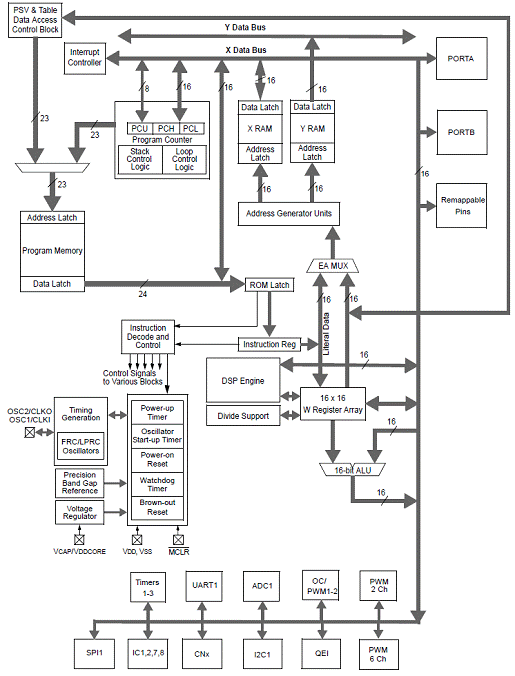
图1.dsPIC33FJ12MC201/202 方框图
dsPICDEM™ MCHV开发系统
The Microchip dsPICDEM™ MCHV Development System is intended to aid the user in the rapid evaluation and development of a wide variety of motor control applications using a dsPIC® Digital Signal Controller (DSC). This development system is targeted to control Brushless DC (BLDC) motors, Permanent Magnet Synchronous Motors (PMSM), and AC Induction Motors (ACIM) in sensor or sensorless operation. This flexible and cost-effective tool can be configured in different ways for use with Microchip’s specialized Motor Control DSCs. The dsPICDEM™ MCHV Development System supports the dsPIC33F Motor Control device family, and offers a mounting option to connect either a 28-pin SOIC device or a generic 100-pin Plug-In Module(PIM).
The system has a three-phase power module device that contains the motor inverter and the gate driver’s circuitry. The circuit drives a BLDC, PMSM, or ACIM motor using different control techniques without requiring any additional hardware. It also has Power Factor Correction (PFC) circuitry in order to provide a full set of tools used in motor control applications.
The rated continuous output current from the inverter is 6.5A (RMS). This allows up to approximately 2 kVA output when running from a 208V to 230V single-phase input voltage in a maximum 30ºC (85ºF) ambient temperature environment. Therefore, the system is ideally suited for running a standard 3-Phase Induction Motor of up to 1.4 kW (1.8 HP) rating or a slightly higher rated industrial servo-motor. The power module is capable of driving other types of motors and electrical loads that do not exceed the maximum power limit and are predominantly inductive. Furthermore, single-phase loads can be driven using one or two of the inverter outputs.
dsPICDEM™ MCHV开发系统主要特性:
Supported Devices:
• 28-pin to 100-pin dsPIC33FJXXXMC202 PIM (MA330014) with a dsPIC33F Motor Control device (U11) socket
• 44-pin to 100-pin dsPIC33FJXXXMCX04 PIM (MA330017 and MA330018) with a dsPIC33F Motor Control device (U11) socket
• 100-pin to 100-pin dsPIC33FJXXXMCX10 PIM (MA330013) with a dsPIC33F Motor Control device (U11) socket
• dsPIC33FJ12MC202 Motor Control device in a SOIC package (U12) footprint
Motor Control Interfaces:
• Three-phase inverter bridge with a power rating of 400V/6.5A (J17)
• Hall sensors/Quadrature Encoder Interface (QEI) for sensored motor control algorithms (J9)
• Phase voltage feedback for sensorless BLDC operation
• DC bus current sense resistor for single shunt vector control
• Phase current sense resistor for dual shunt vector control
• Overcurrent protection
Input/Output Control Switches:
- One isolated push button (S1)
- Isolated reset push button (RESET)
- Isolated 10 k potentiometer (POT1)
- LED indicator for PWM outputs
Isolated Communication Ports:
- UART communication via USB (J6)
- UART communication via RS-232 (J8)
Built-In Isolated Programmer/Debugger (J20):
- Starter Kit-type programmer/debugger (daughter card)
Power Supply Connectors:
- Power Tab Fast-On connectors (BP1 and BP2) for the power stage
- Auxiliary 24V power input connector (J15) for the dsPIC DSC device and
low-power circuitry (non-populated)
- Auxiliary 15V and 3.3V regulators for regulating auxiliary power supply
(non-populated)
Programming Connectors:
- ICSP™ connector for programming a dsPIC DSC device (J18), non-isolated
- ICSP connector for programming the PIC18LF2450 USB module to the UART
Bridge (J1), isolated
- ICSP connector for programming the Starter Kit Programmer/Debugger
(SKDE), isolated PIC18F67J50 (J4)
Power Factor Corrector:
- Maximum input voltage 90 VAC-265 VAC
- Current Feedback circuitry
- VAC input voltage sensing
- Zero-crossing detection
- DC bus sensing
- Overcurrent protection (The maximum power available is specified in
Section 4.3 “Electrical Specifications”.)Built-In Power Supplies:
- 15V power supply, maximum power available 11W
- 3.3V power supply, maximum power available 2W
Additional Protection Circuitry:
- 250 VAC/15A fuse
- In-rush current limiter
- EMI filter
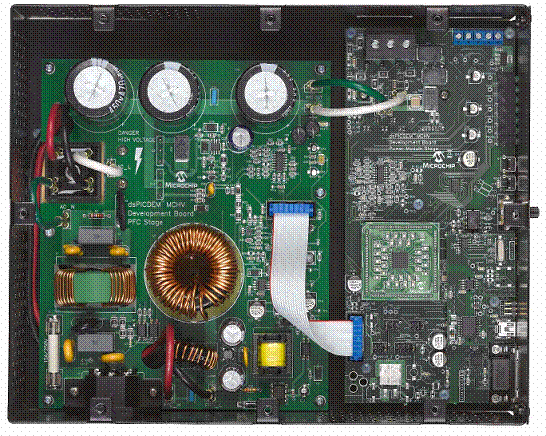
图2.dsPICDEM™ MCHV开发系统外形图
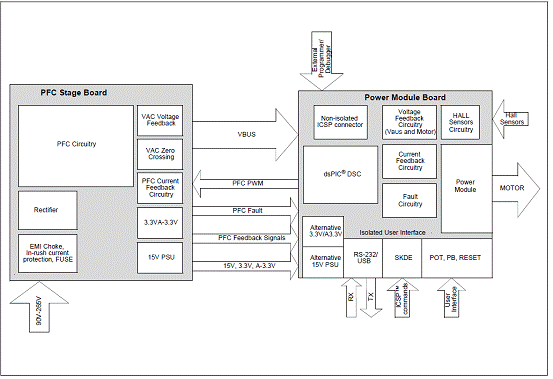
图3.dsPICDEM™ MCHV开发系统方框图
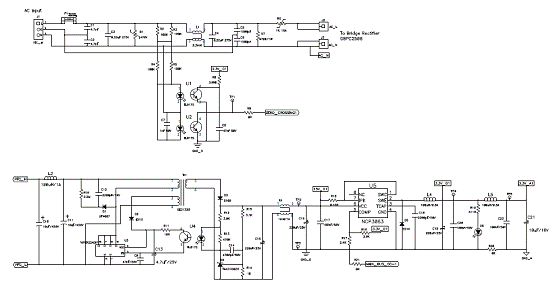
图4.dsPICDEM™ MCHV开发系统PFC级电路图(1)
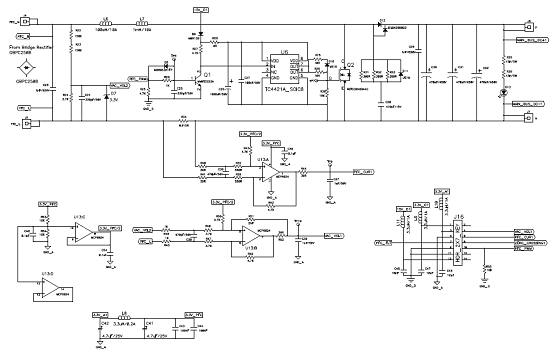
图5.dsPICDEM™ MCHV开发系统PFC级电路图(2)
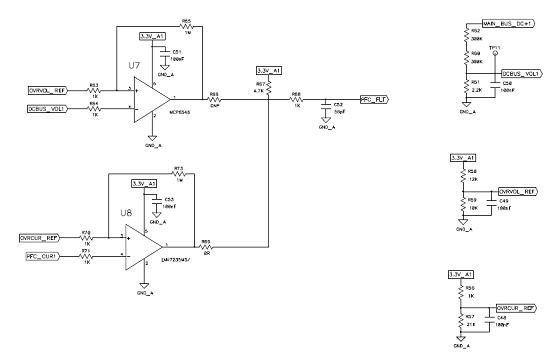
图6.dsPICDEM™ MCHV开发系统PFC级电路图(3)
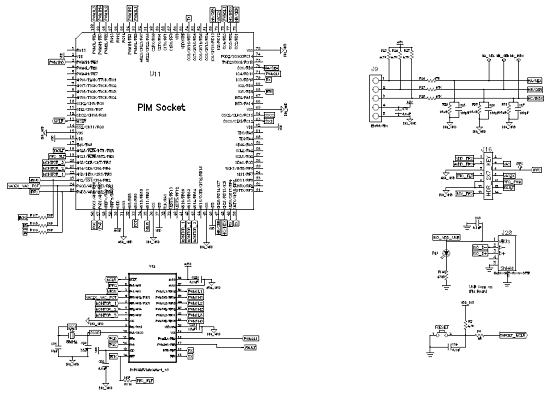
图7.dsPICDEM™ MCHV开发系统功率模块级电路图(1)
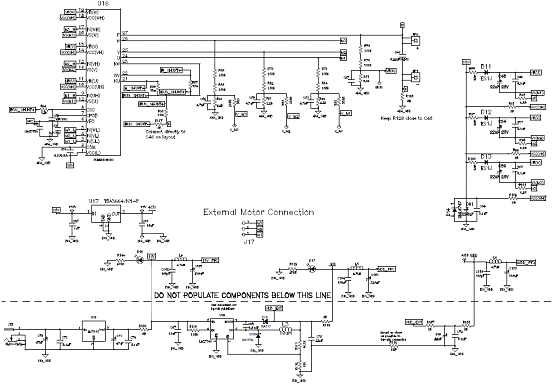
图8.dsPICDEM™ MCHV开发系统功率模块级电路图(2)

图9.dsPICDEM™ MCHV开发系统功率模块级电路图(3)
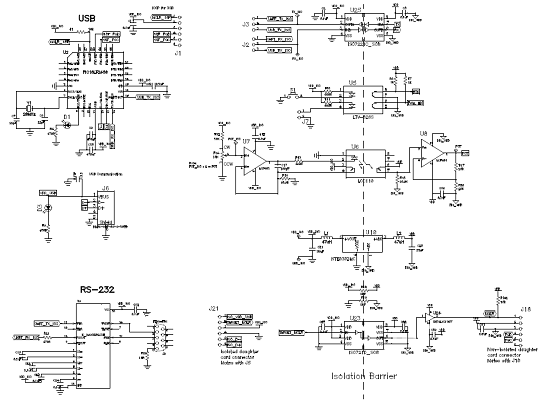
图10.dsPICDEM™ MCHV开发系统功率模块级电路图(4)
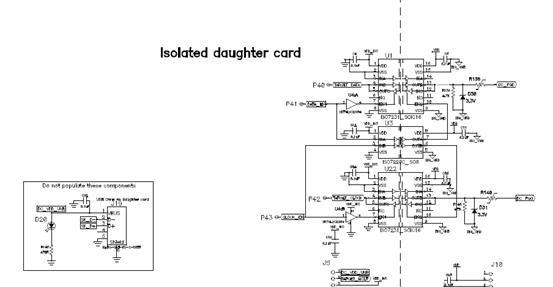
图11.dsPICDEM™ MCHV开发系统功率模块级电路图(5)
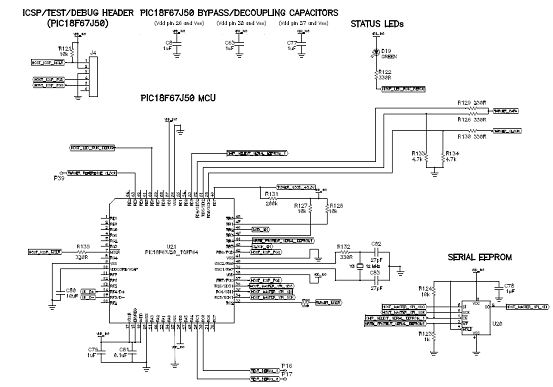
图12.dsPICDEM™ MCHV开发系统功率模块级电路图(61)
责任编辑:David
【免责声明】
1、本文内容、数据、图表等来源于网络引用或其他公开资料,版权归属原作者、原发表出处。若版权所有方对本文的引用持有异议,请联系拍明芯城(marketing@iczoom.com),本方将及时处理。
2、本文的引用仅供读者交流学习使用,不涉及商业目的。
3、本文内容仅代表作者观点,拍明芯城不对内容的准确性、可靠性或完整性提供明示或暗示的保证。读者阅读本文后做出的决定或行为,是基于自主意愿和独立判断做出的,请读者明确相关结果。
4、如需转载本方拥有版权的文章,请联系拍明芯城(marketing@iczoom.com)注明“转载原因”。未经允许私自转载拍明芯城将保留追究其法律责任的权利。
拍明芯城拥有对此声明的最终解释权。




 产品分类
产品分类















 2012- 2022 拍明芯城ICZOOM.com 版权所有 客服热线:400-693-8369 (9:00-18:00)
2012- 2022 拍明芯城ICZOOM.com 版权所有 客服热线:400-693-8369 (9:00-18:00)


